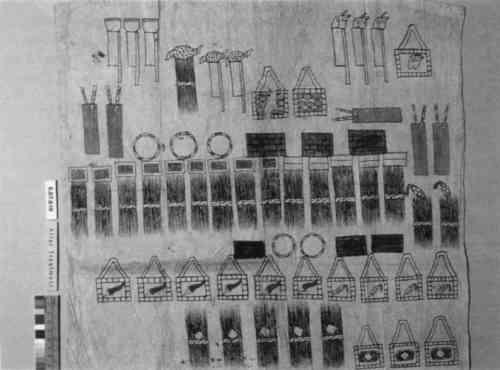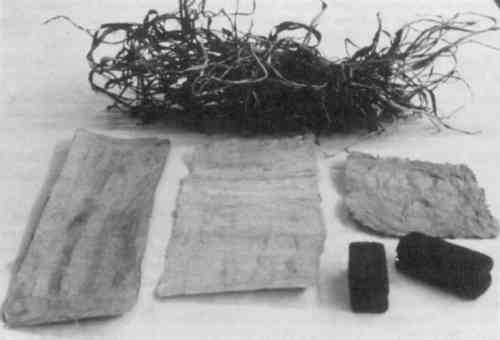THE EXAMINATION AND CONSERVATION TREATMENT OF THE LIBRARY OF CONGRESS HARKNESS 1531 HUEJOTZINGO CODEXSYLVIA RODGERS ALBRO, & THOMAS C. ALBRO
10 TREATMENT OF THE DRAWINGSIT WAS first necessary to relax and flatten the drawings before mending could be accomplished. In general, the amatl papers were in poorer condition than the maguey papers and had more areas of loss and shredding where they had been folded. Each drawing was humidified in a chamber, and after about three hours of exposure, it could be unfolded and the large wrinkles gently pulled out. After humidification, each drawing was friction mounted between kizukishi lightweight Japanese paper and dried between thick (5/8 in) felts weighted with a piece of Plexiglas (Keyes 1984). Careful control of moisture during this process avoided disturbing the pigments. The Japanese papers were matched in thickness and grain direction to the Mexican drawings, which had a pronounced direction associated with the pounding pattern imparted during their manufacture. The friction mounting gently removed most of the creases, fine wrinkles, and distortions in the papers. A few severe wrinkles that remained were removed by local humidification with moist blotters and selective weighting. In some areas of more serious shredding, local humidification enabled fibers to be repositioned with tweezers under magnification. Thus design areas that had warped because of distortion of the fibers over time were straightened out. Consolidation of the unstable pigments was done using parchment size adhesive that was diluted with isopropyl alcohol and water and then applied with a fine brush under a microscope.16 A modified version of Mexican traditional papermaking was adapted to fill the losses in the drawings (fig. 15). Mexican amate fibers that had been cleaned, soaked, and boiled with fireplace ash and calcium carbonate were made into a pulp slurry with a blender.17 Very little adjustment in the color of the fiber fills was necessary. Some acrylic color was added to the amate fiber pulp mixture in areas where the drawing paper was different in color. Over a light box and with a polyester film sheet covering the drawing to be filled, pulp was shaped to correspond with the areas of loss. The formed fills were dried between blotters without weight, to preserve the fiber texture, and then remoistened with a light mist and tamped into place using a Japanese stippling brush (fig. 3). No adhesive was required to keep these fills in place. The stippling brush was successful in blending the long fibers together (perhaps because they both are of the mulberry family, the fibers seemed to have an affinity for each other). A light application of pastel was used occasionally to adjust the color of the fills, which are reversed by pulling them away with a tweezer. To provide additional reinforcement to especially weak or thinned areas, small strips of tengujo paper toned with acrylic were tamped into place in the same way, sometimes using a watery wheat-starch paste on the water-cut fiber edges. After local weighting it was not always easy to distinguish the fills from the original. However, examination with ultraviolet light and raking light make this identification very simple.
The maguey papers were treated in the same manner as the amatl, but required less filling and mending (fig. 5). When repair was completed, the Indian drawings were hinged with Japanese paper and wheat-starch paste into mats of a sympathetic color (fawn Museum Mounting Board). A photograph of the verso of each drawing was included in each mat to discourage handling the original in the future. The matted drawings are housed together in a custom-made box that accompanies the boxed and bound manuscript in the Manuscript Division.
ACKNOWLEDGEMENTSTHE AUTHORS would like to thank their colleagues at the Library of Congress, without whom they could not have completed this project, especially: Guadalupe Jim�nez Codinach and John H�bert of the Hispanic Division, Richard Bickel of the Manuscript Division, Peter Waters of the Conservation Office, and Carole Zimmerman of the Preservation Office Library. Karen Garlick of the National Archives, formerly of the Library of Congress, was exceedingly helpful in all aspects of the project. Susan Kern, papermaker and artist, was of great assistance in the study and repair of the Indian papers. This paper was presented at the 16th annual meeting of the American Institute for Conservation in 1988. |


